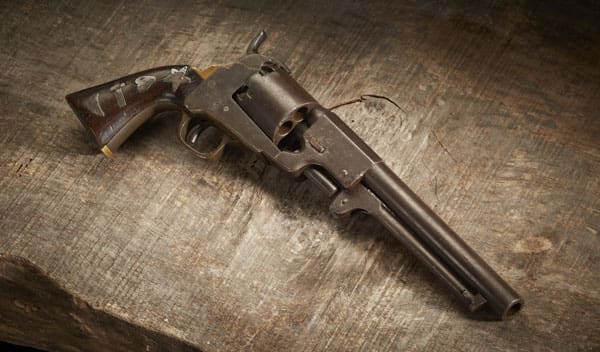
Revolvers made by Dance are some of the most distinctive guns to come out of the south. While they are copied from the Colt Dragoon, they differ in a very important aspect of appearance. Dance revolvers lack a recoil shield on both sides of the gun, giving their frame a very flat look. Made in .36 and .44 caliber, both models lack recoil shields.
James Henry Dance and his brothers were descended from a color bearer who served directly under General George Washington. Not long before the Civil War, James left home in Alabama and headed to Texas. A year later, his three brothers and two sisters joined him, where they purchased 900 acres and opened a large-scale blacksmith shop.
Production on revolvers began in 1862 in East Columbia, Texas, after Governor Lubbock received a letter signed by 26 prominent citizens of the city. Because revolvers were in such high demand, Governor Lubbock exempted Dance factory workers from military service. He felt that they served a greater purpose in making guns for fighting than actually fighting themselves.
Many contemporaries believed the Dance revolvers to be a superior design. In September 1862, The Houston Tri-Weekly Telegraph called the guns “superior to Colt’s best” in one of their columns.
By 1863, Union forces became aware of the Dance factory and it quickly became a target. The company decided to relocate a few miles away to avoid being shelled by gun boats on the Brazos River. Upon relocation, the factory was supposed to pick up where they left off and keep making revolvers. For one reason or another, production never resumed.
The exact number of J.H. Dance & Brothers revolvers made is unknown; estimates put it somewhere between 325 and 500. The majority were made in .44 caliber, making the smaller .36 caliber models rarer than their larger counterparts. One should exercise extreme caution when considering purchase of a supposed-original Dance revolver, especially the rarer 36-caliber version; many fakes have been made with great ease by removing the recoil shield on Colt revolvers.
(Firearm courtesy of NRA Museums)
Logan Metesh is a firearms historian and consultant who runs High Caliber History LLC. Click here for a free 3-page download with tips about caring for your antique and collectible firearms.




Starting to see a pattern from the past three days…
Did the CSA never come up with any truly original designs? Or was simply copying Colt the most expedient solution at the time?
Never mind… that was probably it.
Until the Remington began full scale production in 1861, Colt was the name of the game for a revolver in large production, and everything else were mostly copies, except the Whitney (roughly 33,000 copies made in New Jersey), which was designed by the same man who went on to design the Remington. One important fact as to why this is the case is that the Colt patent for his revolver expired in 1857.
Even copying already existing and mass produced models got the south no where. Confederate production of revolvers were pathetic in scale. It’s almost as if the workers understood they were serving a corrupt cause and didn’t have their hearts in it.
It had a lot more to do with lack of facilities, lack of materials, and lack of trained gunsmiths. If I recall correctly, there were no or very limited steel production facilities in the south. One of the issues lading up to the war was that the south produced raw materials from farming, while the mills were all located in the north. The south lacked any natural source of iron as well, which is why so many of their guns were made with brass frames. I also seem to recall that at the start of the war, there was only one cannon foundry in the whole confederacy.
I think that the validity of the cause has some part to play in it. Were the southern states at any more of a disadvantage than the Israelis in 1947?
Yet Israel is its own nation and the confederacy was put down. Good people with a valid cause find a way to overcome.
Give it a rest JWM your SJW is showing
That is an incorrect statement, sir.
That is a beautiful looking piece.
Thank you so much for writing about these.
Considering that most Confederate guns were made in haste in inferior factories with whatever materials the rebels could manage to scrape together, they were still beautiful. And they worked.
Comments are closed.